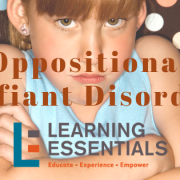Background
While oppositional defiant disorder (ODD) was added to the DSM in the 1980s, its existence and diagnosis is still hotly debated and somewhat misunderstood among families and educators. Surprisingly enough, ODD is one of the most common behavioral disorders to be diagnosed in children. Furthermore, researchers have also found that oppositional defiant disorder in both boys and girls is often accompanied by a previous ADHD diagnosis.
Symptoms
While ODD is a disorder that affects both boys and girls, symptoms are typically known to vary between the sexes. Though this is in no way absolute, researchers have found that boys with ODD display their opposition and defiance in more physically aggressive manners; their frustrations may escalate quickly and in more overtly explosive ways. While girls, on the other hand, are more likely to display oppositional or defiant behaviors in subtle, sneaky, or manipulative ways. For instance, girls with ODD may be deceitful or cunning and interact with others in intentionally uncooperative ways. Again, these are not hard and fast rules; they are simply some of the known observations experts have made between the genders.
It is also important to note that symptoms associated with ODD are typically misbehaviors that most children and teens will display at some point during their development. However, the difference between mere misbehaviors or teenage moodiness and ODD is the prevalence and severity of the behaviors. With regard to a diagnosis, ODD behaviors have likely become so frequent that they are deemed as the “norm” for that child.
Support in the Classroom
| Behavior |
Support |
Additional Considerations |
| Disproportionate anger/frustration/
irritability |
- Provide student with flash pass to the counselor for when tempers flare
- Allow student to take brief “brain breaks” throughout the day, especially when transitioning between activities or subject areas to alleviate stress
- Provide student with preferential seating near the door for easy access to the hallway if frustration escalates
- Provide student with fidget cube or stress ball to channel negative energy
|
- Classrooms as a whole can benefit from stress-relieving or meditative practices, but these coping skills are especially beneficial to students with ODD; schools and counselling departments are beginning to focus students’ attention on mental self-care and coping methods to reduce anxiety and stress
|
| Argumentative, uncooperative, defiant towards adults/authority figures |
- Present requests or directives in the form of an “either/or” question. For example, if a student throws paper off the desk, the teacher might say, “Would you like to either pick up the paper now, or pick up all scrap paper at the end of class?”
- Remind student that his/her defiance is a choice that will result in a consequence; ask him/her if she would like to make a different choice to amend the tone/behavior/attitude
- Stay calm; you cannot fight fire with fire. As difficult as it may be, teachers and other adults must remember that the ODD behaviors are stemming from a larger issue.
|
- Deescalate the tone of the situation by maintaining a calm, understanding, yet firm demeanor. Act with care and be deliberate in your directives toward the student.
- Remind students that you are there FOR THEM; everything you do is meant to ensure safety and success in the classroom. By reaffirming your desire to help him/her, a defiant student may soften the edge and be more receptive to your requests.
|
| Physical aggression; vindictive, spiteful, or manipulative behavior |
- Physical altercations are never okay; remind students that verbal disagreements should never escalate to physical interactions
- If something physical does transpire, adults must be sure to document the situation thoroughly. This includes all parties involved, what instigated the issue, and anyone who may have witnessed the altercation. Teachers should also note when and where the event took place so that administration and parents are made aware of the full situation.
|
- Teachers can consider activities or brain breaks that either diffuse or expel aggression or anger.
- Items such as Rubik’s cubes, coloring books, or sudoku challenges help students to come down off of the aggressive moment by occupying the mind
- Consider creating a small, comfortable, secluded corner of the room where students can take a breath and collect themselves before re-entering the classroom environment
- Teachers and guidance counselors can help to mediate aggression and manipulative behaviors by helping students to reflect on an incident. Prompt students to think about why they lied, cheated, manipulated, etc. Ask them what they could have done differently that would have resulted in a more positive outcome.
|




